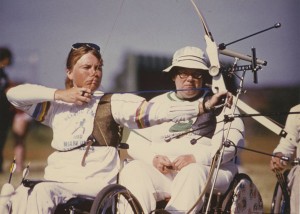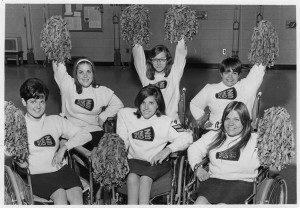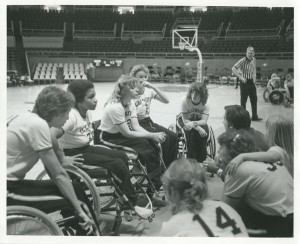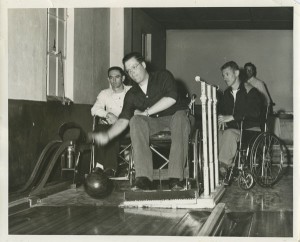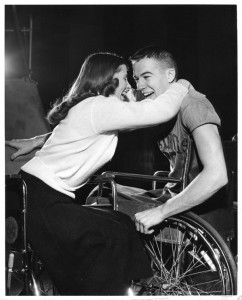The Division of Rehabilitation-Education Services (DRES) records have been made available due to the generous support of B. Joseph White and the President’s office. DRES records were processed and selectively digitized for online exhibition in 2008-2009.
The Gizz Kids program was created in 1948 by Timothy Nugent and was run by the service fraternity Delta Sigma Omicron as a program of sports available to student-athletes with disabilities. The intention of the program mirrors that of DRES: to offer students with disabilities the ability to fully experience college and all of its many opportunities, athletics included. The Gizz Kids program grew to include a number of sports, including football, basketball, baseball, track and field, fencing, archery, cheerleading, and square dancing for students in wheelchairs. The program also included bowling for the blind and adaptive swimming.
The Gizz Kids program was an important one for both students in the Rehabilitation-Education program and the general public. The fierce competition that one expects in college athletics was retained in each of the adapted Gizz Kids sports; the program became an important tool in educating the public. The program showed the general public the strength, skill, and abilities of athletes with disabilities and motivated other students and younger people with disabilities. To mirror traditional basketball, the wheelchair basketball organization followed NCAA regulations exactly, excepting three modifications [1].
Wheelchair basketball athletes played a regular season, in addition to exhibition games throughout the region. These games were played against teams from other colleges, high schools, and communities, who were put into wheelchairs for the game. Like traditional college basketball, the team brought its own squad of varsity cheerleaders. The Gizz Kids Square Dance team, known for their skill and precision, performed during halftime [2]. These games, and the regular conference season games, have been a major source of income for the program. The highly attended basketball games served as the primary source of funding for the project. In addition, over half of the profit from ticket sales have gone to charitable causes, reflecting the Delta Sigma Omicron dedication to service. By 1970, the Gizz Kids had donated over $50,000 to charity [3].
By 1971, female students formed a basketball team and called themselves the “Ms. Kids.” The team won the first U.S. Women’s Wheelchair basketball game, which was also the “first women’s intercollegiate wheelchair basketball game” in February 1974 [4]. National interest and participation in the sport grew from there.
The Gizz Kids were valuable not only to wheelchair athletics at the U of I. They were leaders in founding the National Wheelchair Basketball Association and they held the first National Wheelchair Basketball Tournament in 1950 (1- “National Wheelchair Basketball Association”. The Gizz Kids were made up entirely of undergraduates; alumni and graduate students founded their own time in Champaign-Urbana, the Black Knights [5]. The development of a robust program of wheelchair athletics for students and, as they developed, adults, supported people “who ha[d] otherwise been denied participation in universally accepted competitive physical activities” [6].
Nugent and the Gizz Kids were valuable because they proved the importance of competitive athletics as a form of therapy, an idea that had been dismissed by doctors and therapists. It also provided a structured and established athletic association for people with disabilities looking to compete. As Nugent explained, “Most of the basketball teams…ha[d] been founded by the disabled themselves who put it together without any professional background…There hasn’t been leadership on the part of the professionals” [7]. With the Gizz kids and the Wheelchair Basketball Association, professionals began to see the value in providing athletic therapy to people with disabilities.
The Gizz Kids was a leader in a number of other sports; the program brought the first wheelchair football and wheelchair softball teams in the world. Many students went on to found other teams and leagues across the country and participated in the Paralympics for the United States, starting in 1960, the first year that the US sent athletes to the Paralympic Games [8]. A number of former Gizz Kids have gone on to be honored by the Wheelchair Sports Hall of Hall. Timothy Nugent, founder of DRES, the Gizz Kids, and the organizer of wheelchair basketball, was the first non-athlete contributor to be inducted to the Wheelchair & Ambulatory Sports USA Hall of Fame in 1970 [9].
—–
For more information on the history of the Gizz Kids and wheelchair basketball, see RS 16/6/5
Interested in catching a wheelchair athletics game? Check out the DRES website for more details.
[1] Journal of Health Physical Education Recreation (JOPHER). Index to Vol. 41, 1970. p. 5.
[2] JOPHER. Index to Vol. 41, 1970. p. 3
[3] Expanding Horizons. 1998.
[4]”Ladies of the Court.” Sports ‘N Spokes. November/December 1975. p. 7.
[5] Expanding Horizons. 1998.
[6] Therapeutic Recreation Journal. Vol. XII, No. 1. 1978. p. 14.
[7] “Is Medicine Catching Up with the Wheelchair Athlete?” The Physician and Sportsmedicine. July 1974. p. 51-57.
[8] JOPHER. Index to Vol. 41, 1970. p. 1.
[9] Wheelchair & Ambulatory Sports, USA.
Photos are from RS 16/6/11, DRES Photograph File

